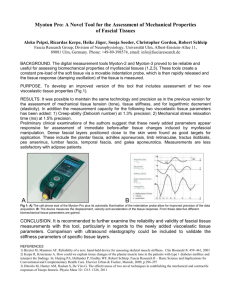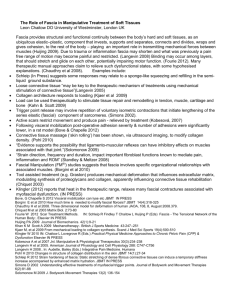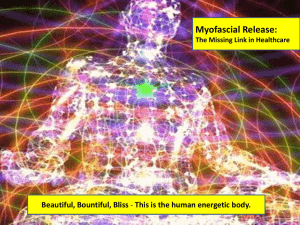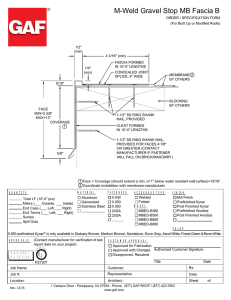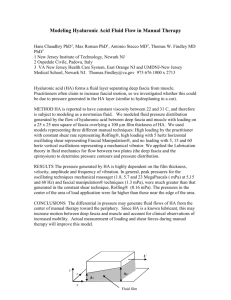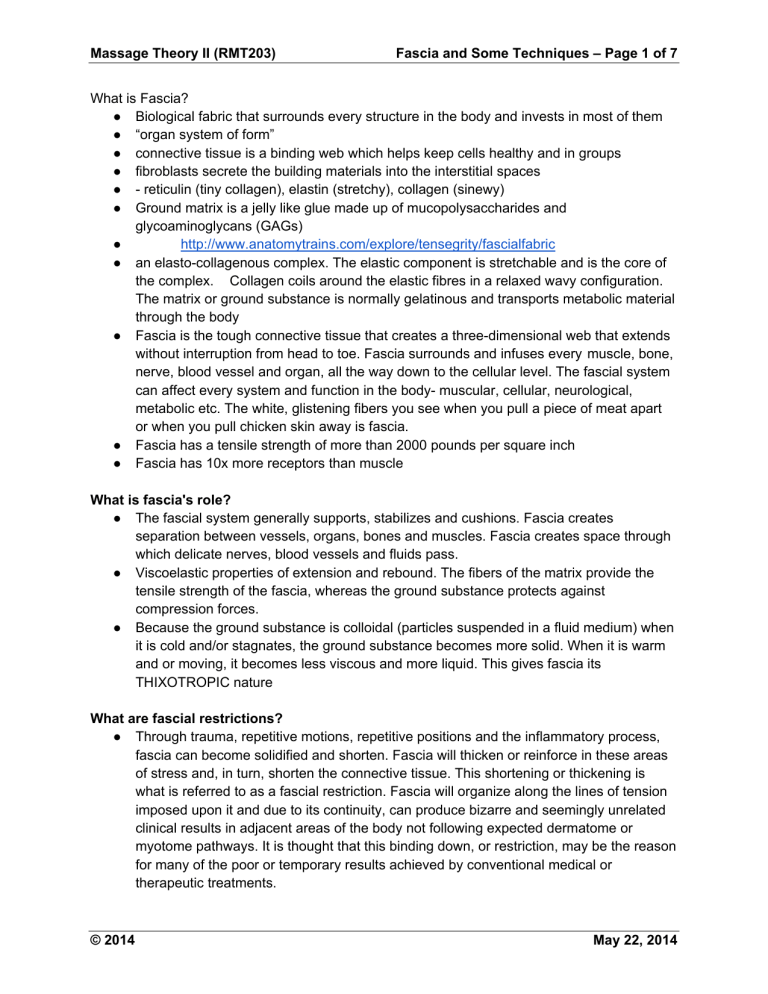
Massage Theory II (RMT203)
Fascia and Some Techniques – Page 1 of 7
What is Fascia?
● Biological fabric that surrounds every structure in the body and invests in most of them
● “organ system of form”
● connective tissue is a binding web which helps keep cells healthy and in groups
● fibroblasts secrete the building materials into the interstitial spaces
● - reticulin (tiny collagen), elastin (stretchy), collagen (sinewy)
● Ground matrix is a jelly like glue made up of mucopolysaccharides and
glycoaminoglycans (GAGs)
●
http://www.anatomytrains.com/explore/tensegrity/fascialfabric
● an elasto-collagenous complex. The elastic component is stretchable and is the core of
the complex. Collagen coils around the elastic fibres in a relaxed wavy configuration.
The matrix or ground substance is normally gelatinous and transports metabolic material
through the body
● Fascia is the tough connective tissue that creates a three-dimensional web that extends
without interruption from head to toe. Fascia surrounds and infuses every muscle, bone,
nerve, blood vessel and organ, all the way down to the cellular level. The fascial system
can affect every system and function in the body- muscular, cellular, neurological,
metabolic etc. The white, glistening fibers you see when you pull a piece of meat apart
or when you pull chicken skin away is fascia.
● Fascia has a tensile strength of more than 2000 pounds per square inch
● Fascia has 10x more receptors than muscle
What is fascia's role?
● The fascial system generally supports, stabilizes and cushions. Fascia creates
separation between vessels, organs, bones and muscles. Fascia creates space through
which delicate nerves, blood vessels and fluids pass.
● Viscoelastic properties of extension and rebound. The fibers of the matrix provide the
tensile strength of the fascia, whereas the ground substance protects against
compression forces.
● Because the ground substance is colloidal (particles suspended in a fluid medium) when
it is cold and/or stagnates, the ground substance becomes more solid. When it is warm
and or moving, it becomes less viscous and more liquid. This gives fascia its
THIXOTROPIC nature
What are fascial restrictions?
● Through trauma, repetitive motions, repetitive positions and the inflammatory process,
fascia can become solidified and shorten. Fascia will thicken or reinforce in these areas
of stress and, in turn, shorten the connective tissue. This shortening or thickening is
what is referred to as a fascial restriction. Fascia will organize along the lines of tension
imposed upon it and due to its continuity, can produce bizarre and seemingly unrelated
clinical results in adjacent areas of the body not following expected dermatome or
myotome pathways. It is thought that this binding down, or restriction, may be the reason
for many of the poor or temporary results achieved by conventional medical or
therapeutic treatments.
© 2014
May 22, 2014
Massage Theory II (RMT203)
●
●
●
●
Fascia and Some Techniques – Page 2 of 7
It is believed that when we are traumatized, experience inflammatory processes, or have
poor habitual posture or movements over time, changes take place to the fascia.
Elastocollagenous crosslinks can develop at the nodal points of the fascia and the
viscosity of the ground substances changes to a more solid state.
What causes these restrictions? Life! Anything from past accidents and traumas to
repetitive positioning or activities. These restrictions slowly build up until it becomes
more difficult and,many times, painful to move.
http://pcmclinic.com/myofascial.html
Myofascial release, the search for excellence – John F Barnes,
PT
Tensegrity
● "Tensegrity" derives from collapsing the words "tension" and "integrity" and means
that the integrity of these class of structures depends on the balance of tension within
it.
● All structures in the universe are supported by a balance between tension and
compression, between "push" and "pull". The chair sits on the floor, the lamp hangs from
the ceiling - that's all the ways to support something there are. Shear, bending, and other
forces are just combinations of basic tension and compression.
● We are very used to looking at and building structures that rely primarily on
compression for support. The brick wall is the classic example: one brick is piled on top
of
the other. This is a "continuous compression" structure - where the compression
created by gravity is carried from one brick to another, all the way to the ground. The
bottom brick has to be compressively strong enough to carry all the bricks above it.
● In tensegrity models, stress is reflected throughout the system rather than being
confined to the precise point of stress. Imagine wearing a full body stretch suit
with
one sleeve that is one size smaller than the rest of the suit. When the arm in the smaller
sleeve is raised, the movement creates compression and pulling across the upper body
and down into the hips.
Myofascial Release
●
Whole body hands on approach for the evaluation and treatment of the body with the
focus on the fascial system. Inappropriate fascial strain may be caused by trauma or
any postural, systemic, ergonomic or mechanical perpetuating factor.
●
Fascia reorganizes along the lines of tension imposed on the body, adding support to
misalignment and contracting to protect the individual from further trauma (real or
imagined). This has the potential to alter organ and tissue physiology significantly.
Fascial strains can slowly tighten, causing the body to lose it's physiologic adaptive
capacity – see tensegrity. Over time, the tightness spreads like a pull in a sweater or
stocking. Flexibility and spontaneity of movement are lost, setting the body up for more
trauma, pain and limitation of movement. These powerful fascial restrictions begin to pull
the body out of its 3D alignment with the vertical gravitation axis, causing
biomechanically inefficient, highly energy consuming movement and posture.
© 2014
May 22, 2014
Massage Theory II (RMT203)
Fascia and Some Techniques – Page 3 of 7
●
Myofascial Release is a safe and very effective hands-on technique that involves
applying gentle sustained pressure into the Myofascial connective tissue restrictions to
eliminate pain and restore motion. This essential “time element” has to do with the
viscous flow and the piezoelectric phenomenon: a low load (gentle pressure) applied
slowly will allow a viscoelastic medium (fascia) to elongate.
●
The gentle tractioning forces will elicit heat, a vasomotor response that increases blood
flow to the affected area, enhance lymphatic drainage of toxic metabolic wastes, realign
fascial planes, and reset the soft tissue proprioceptive sensory mechanism.
●
The goal is to remove restrictions
and restore the body's equilibrium
http://www.myofascialrelease.com/fascia_massage/public/whatis_myofascial_release.asp
Therapeutic Massage in Athletics by Pat Archer
Contraindications:
Malignancy
Open wounds
Cellulitis
Sutures
Fever
Hematoma
Systemic or localized infection
Healing Fracture
Aneurism
Osteoporosis
Osteomyelitis
Severe peripheral vascular disorders
Anticoagulant therapy
Hypersensitivity of the skin
© 2014
May 22, 2014
Massage Theory II (RMT203)
Advanced diabetes (neuropathy)
Fascia and Some Techniques – Page 4 of 7
Acute inflammatory conditions
Connective tissue disorder (ie rheumatiod
arthritis)
Assessment:
●
●
●
●
●
●
●
© 2014
Tissue should be soft and pliable. Compare bilaterally
Tenderness, heat or hard areas are telling you where the problem lies
Hardness means that fascia has tightened and developed cross-links or its ground
substance has solidified.
Restrictions may also have a crunchy feel which means the matrix has lost its fluid
consistency and crystallized
Localized superficial subdermal fascial restriction due to scar tissue or adhesion may
manifest as superficial subdermal “stuckness” or restriction. Skin and subdermal tissue
does not want to move freely and lift up and away from underlying tissues. The skin may
dimple, cleave or pucker
Check skin for mobility - 360 degree assessment or “around the clock”. Place your hand
flat on the surface of the skin and move it slowly in all directions. Ideally, it should move
equally in all directions, except around tendinous insertions into osseous structures.
Other ways to assess - visual scan, formal postural assessment, skin rolling
May 22, 2014
Massage Theory II (RMT203)
Fascia and Some Techniques – Page 5 of 7
Techniques: superficial and deep
- please remember some techniques can be both superficial and deep depending on the
structures you are intending to affect.
●
●
●
●
●
●
●
●
●
●
●
●
Skin rolling (static and dynamic)
Shearing
Vertical stroking
C-bowing, S-bowing, torquing
J stroking
Transverse stroking (“strumming”)
Bear Claw
Cross Hand release
Myofascial arm pull
Myofascial leg pull
Cutting
Spreading
J Stroke:
Increases Skin mobility and can be used anywhere on body, wherever restrictions are found
Apply counter pressure with the heel of one hand
In the direction of restriction, drag two or three fingers or a knuckle across skin. The J is a
torque at the end of the motion designed to break up the crosslinks in the fascial system
Vertical Stroke:
Opens the length of vertically oriented superficial fascia. It is used in a longitudinal direction
along the length of a limb or on specific muscle groups such as hamstrings, quads, TFL,
anterotibial compartment, plantar fascia, pectorals, forearm and paraspinals
Ease the pressure over popliteal and antecubital fossae
You can apply counter pressure with heel of one hand (like a x hand release). Pressure is
applied with opposite fingers, hand, knuckle or elbow along the length of a limb or muscle group
Position patient to maximize the stretch through the area
Transverse Stroke
Downward force is applied with the fingertips in to the muscle and then moved in a strumming
motion perpendicular to the muscle fibres.
It is not a comfortable technique if performed correctly; however it is extremely effective and can
be used all over the body, such as the paraspinals, pec major, and minor, levator scapulae,
psoas, piriformis, abductors etc.
© 2014
May 22, 2014
Massage Theory II (RMT203)
Fascia and Some Techniques – Page 6 of 7
Bear Claw
A form of transverse stroking to be used to clear the gluteal and hip regions, or other fan shaped
muscles. Use in patients with low back pain, sciatic pain and lower quadrant dysfunction.
One or two hands are held in a position similar to a bear claw. Finger pressure applied to gluteal
region. Then use as strumming motion, like windshield wipers to clear the inferior iliac crest and
hip area. Work through the entire gluteal region and around greater trochanter of the femur.
Skin Rolling
Grasp tissue between index finger/middle finger and thumbs and lift it away from underlying
structures. Slowly strain and hold tissues while pushing into direction of restriction. A bending or
torquing action can be applied for more effect.
Dynamic skin rolling is moving the “roll”, Static is holding it
Fascial Shearing
Broad handed. Applied to subdermal layer
Assess for restriction. Using a broad, flat hand, push gently into the direction of restriction and
hold for a release.
** Hold for 3-5 minutes, moving into the next barrier as one releases. You may change direction
slightly as releases occur, just continue to load the restriction gently and follow it as it unwinds
You cannot outmuscle fascia. These techniques are gentle and require patience and palpation
skills
Cross Hand release
Can be superficial or deep. Release restrictions under skin or deeper layers of fascia.
Done with relaxed hands. Place one hand first and apply tension to the structure. Cross other
hand over and slowly stretch out the elastic component of the fascia until you reach a barrier.
Maintain your pressure (don't force through the barrier!!) until you perceive a release. This may
feel like heat building up or a throbbing or fluttering sensation – known as the therapeutic
pulse. The patient may also report a temporary increase in pain. As the barrier releases, you
will feel motion under your hands, but your hands will not slide on the skin. Go with the motion
and continue to maintain pressure as long as the motion persists. There may be multiple
barriers so continue to hold, adjust and wait until the tissue has fully released.
After you have felt the softening, GENTLY release the pressure to come out. Moving quickly
may create a rebound effect on the musculature.
It will be useful to do a full body scan, checking for vasomotor response in other areas that may
have been indirectly affected by your work and indicating an area that is also restricted and
needs treatment.
Myofascial Leg Pull
Do slowly and carefully
Tune into subtle barriers, slight resistance
Phase 1: lower extremity taken into external rotation with dorsiflexion. Traction applied
© 2014
May 22, 2014
Massage Theory II (RMT203)
Fascia and Some Techniques – Page 7 of 7
throughout length of limb. Follow through as a smooth arc into abduction then abduction/flexion,
then flexion. Maintain dorsiflexion. Return to neutral.
Phase 2: Maintain traction and dorsiflexion, move leg into internal rotation and then adduction.
Allow body to roll slowly (trunk rotation), as this will effect a release through the hip, SI and
lumbar fascia
Myofascial Arm Pull
Pt lies supine with arms at side. Therapist takes arm, turns into external rotation and applies a
gentle traction. Slowly take through 360 degrees or pain free range of motion. At any resistance,
hold and wait for barrier to release.
You can maintain traction, roll patients body and pull medial border of scapula laterally.
Stretch can be applied to the fascia over carpal tunnel and through fingers and thumbs too.
© 2014
May 22, 2014

